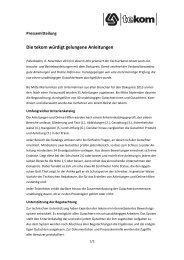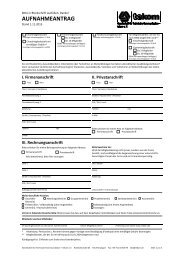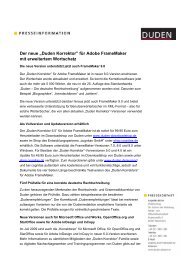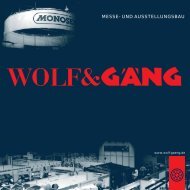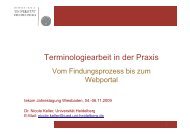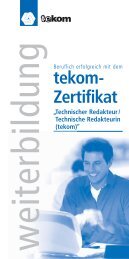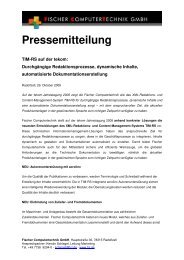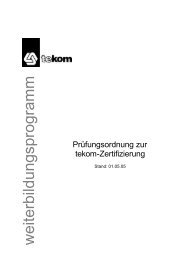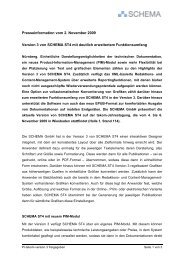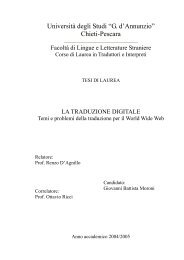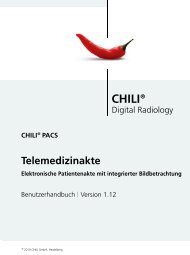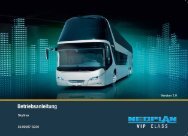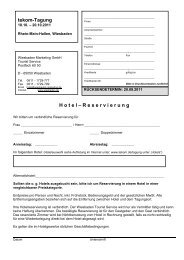Trendthema - Tekom
Trendthema - Tekom
Trendthema - Tekom
Sie wollen auch ein ePaper? Erhöhen Sie die Reichweite Ihrer Titel.
YUMPU macht aus Druck-PDFs automatisch weboptimierte ePaper, die Google liebt.
1<br />
➔ Mittwoch, 19. Oktober 2011<br />
TA 19<br />
Applying usability Techniques<br />
to Documentation<br />
Aruna Panangipally, ibruk Consulting Pvt Ltd,<br />
Mumbai, India,<br />
Rohan Desai, ibruk Consulting Pvt Ltd, Mumbai,<br />
India<br />
Technical Communicators often fret at the lack<br />
of formal techniques that they can apply to create<br />
effective documentation. However, many of<br />
the practices used by UI designers can be easily<br />
adopted by technical communicators. For example,<br />
personas can help define audiences while<br />
card sorting helps in categorizing and organizing<br />
information. This session looks at how practices<br />
from the realm of usability can be adopted to the<br />
process of creating documentation.<br />
➔ Professional level<br />
Tutorial, 08: 5–10: 0, room 1A/5<br />
TA 20 ★<br />
Applying Global english<br />
Style Guidelines to Improve<br />
Readability and Translatability<br />
Leif Sonstenes, Welocalize, Konstanz<br />
Improving the quality of your source text will save<br />
you time, money, and frustration on every future<br />
translation project. The more languages you translate<br />
into, the greater the benefits. In this workshop<br />
we describe Global English and introduce<br />
five style guidelines that improve the readability<br />
and translatability of your source text. Using<br />
example sentences and practical exercises, we<br />
explore each guideline in detail. We also examine<br />
the impact of each guideline on human translators,<br />
non-native speakers, translation memory<br />
tools, and machine translation systems.<br />
➔ Professional level<br />
Workshop, 08: 5–10: 0, room 1A/<br />
TERM 20<br />
crossing the Divide – Selling<br />
Terminology as a Must have<br />
DeAnn Cougler, Professional Linguistic Solutions,<br />
München<br />
To a specialist, the importance of correct terminology<br />
is self-evident; however, conveying this<br />
idea across the board is not always easy and the<br />
complexities involved are often underestimated.<br />
This session covers issues in terminology management<br />
from the perspective of the professional<br />
translator/terminologist:<br />
– Conveying the general importance of terminology<br />
to indirectly concerned parties and decision<br />
makers;<br />
– Implementing a solution by determining the<br />
scope of terminology management and organization<br />
required;<br />
– Demonstrating the feasibility of working with<br />
terminology<br />
➔ Expert level<br />
Tutorial, 08: 5–10: 0, room 16<br />
tekom-Jahrestagung 2011<br />
9: 5–10: 0<br />
KUND 2<br />
Web-Analyse-Methoden zur<br />
Optimierung von Onlinehilfe<br />
einsetzen<br />
Axel Regnet, econda GmbH, Karlsruhe<br />
Mit zeitgemäßen Web-Analyse-Methoden haben<br />
Technische Kommunikatoren alle Werkzeuge in<br />
der Hand, um das Verhalten ihrer Nutzer auf den<br />
Seiten ihrer (Online-)Hilfe zu beobachten. So werden<br />
Schwachstellen identifiziert und eine kontinuierliche<br />
Verbesserung der Hilfe erst ermöglicht.<br />
In dem Vortrag wird anhand konkreter Beispiele<br />
gezeigt, wie Methoden der Web-Analyse für die<br />
Optimierung des Kunden-Nutzens eingesetzt<br />
werden können.<br />
➔ Für Fortgeschrittene. Es wird ein grundlegendes<br />
Verständnis von webbasierten Hilfesystemen<br />
und der prinzipiellen Funktionsweise von<br />
Web-Analyse-Systemen (z. B. google Analytics)<br />
erwartet.<br />
Fachvortrag, Raum 11A<br />
NORM 2 ★<br />
Aktuelle Rechtsentwicklungen in<br />
der Technischen Dokumentation<br />
Jens-Uwe Heuer, Kanzlei Herfurth & Partner,<br />
Hannover, tekom-Beirat für Normen<br />
Der rechtliche Rahmen für die Technische Dokumentation<br />
ist beständig in Bewegung. Dies<br />
betrifft sowohl das durch die Rechtsprechung<br />
ständig fortentwickelte Produkthaftungsrecht wie<br />
auch das Produktsicherheitsrecht. Der Fachvortrag<br />
gibt einen Überblick über die aktuelle Rechtsprechung<br />
und zeigt Tendenzen der gerichtlichen<br />
Bewertung von Technischer Dokumentation auf.<br />
Aktuelle Gesetzgebungsvorhaben wie z. B. die<br />
Novellierung des GPSG werden erläutert. Ein<br />
kurzer Überblick über mögliche zukünftige Entwicklungen<br />
in der Rechtsprechung rundet diesen<br />
Vortrag ab.<br />
➔ Für Einsteiger<br />
Fachvortrag, Raum 6.1<br />
OTS 2<br />
erfolgreiche Anwendung der ASD<br />
S1000D in der zivilen Industrie<br />
am Beispiel Shipdex<br />
Dipl. phys. Falk Aupers, CORENA Deutschland<br />
GmbH, Gießen<br />
Durch die langjährige Historie und Reife der<br />
ASD S1000D Spezifikation deckt sie nicht nur<br />
die Belange der Wehrtechnik und Luftfahrt ab,<br />
sondern erfüllt konsistent auch die Anforderungen<br />
verschiedenster ziviler Industrien, wie z. B. die der<br />
Schifffahrt und des Schienenverkehrs. Mit der offiziellen<br />
Shipdex Adaption wird eine erfolgreiche<br />
Anwendung der ASD S1000D vorgestellt, in die<br />
Interessen von Zulieferern bis Betreibern und eine<br />
Fokussierung auf deren relevante Aspekte eingeflossen<br />
sind. Dadurch werden der kompletten<br />
maritimen Industrie die Vorteile der ASD S1000D<br />
leicht zugänglich gemacht.<br />
➔ Für Fortgeschrittene<br />
Fachvortrag, Raum 6.<br />
UA 9<br />
herausforderungen bei der<br />
lokalisierung multimedialer Inhalte<br />
Kim Harris, text & form GmbH, Berlin<br />
Die Lokalisierung multimedialer Inhalte stellt<br />
sehr spezifische Anforderungen an die technische<br />
Ausstattung, das Know-how und die<br />
Prozessgestaltung des Dienstleisters. Um Kunden<br />
ein Fullservice-Angebot zur Lokalisierung von<br />
Produktinformationen, Schulungsmaterial sowie<br />
eLearning- und Marketing-Inhalten unterbreiten<br />
zu können, müssen zahlreiche Faktoren beachtet<br />
werden, die bei traditionellen Dokumentformaten<br />
nicht relevant sind.<br />
➔ Für Fortgeschrittene<br />
Fachvortrag, Raum 1 D<br />
CS 2<br />
An Introduction to Intelligent<br />
content Strategies<br />
Joe Gollner, Gnostyx Research, Ottawa, Canada<br />
➔ Trend topic, see page 15<br />
lecture, room 11B<br />
LOC 10<br />
Translation evaluation:<br />
Meeting criteria<br />
or finding true excellence?<br />
Angelika Ottmann, EXACT! Sprachenservice und<br />
Informationsmanagement GmbH, Mannheim<br />
Translation evaluation requires the definition of<br />
exact criteria that allow the degree of fulfilment<br />
of the quality requirements to be measured exactly.<br />
The unit of measure is usually an error count<br />
– and the total number of errors the decisive<br />
factor. But: How important for the translation as<br />
a whole is one specific error? How do we measure<br />
excellence? What is the purpose of a quality<br />
control method, besides achieving the best possible<br />
product in one specific case? These and other<br />
questions concerning translation evaluation are<br />
discussed on the basis of a model and examples<br />
from practice.<br />
➔ Professional level<br />
lecture, room 1 B<br />
TA 2<br />
What is DITA 1. ? What is new and<br />
why would I want to implement it?<br />
Thomas Aldous, Adobe Systems, Rehoboth, USA<br />
We have all heard about the DITA standard. There<br />
has been a new update DITA 1.2. The questions<br />
are “What’s New” and “Why would I want to<br />
adopt it”. We will take a deep drive into the DITA<br />
standard and the latest new additions. We will<br />
finish with a live demo of DITA 1.2 in use.<br />
➔ Professional level<br />
lecture, room 1 c



